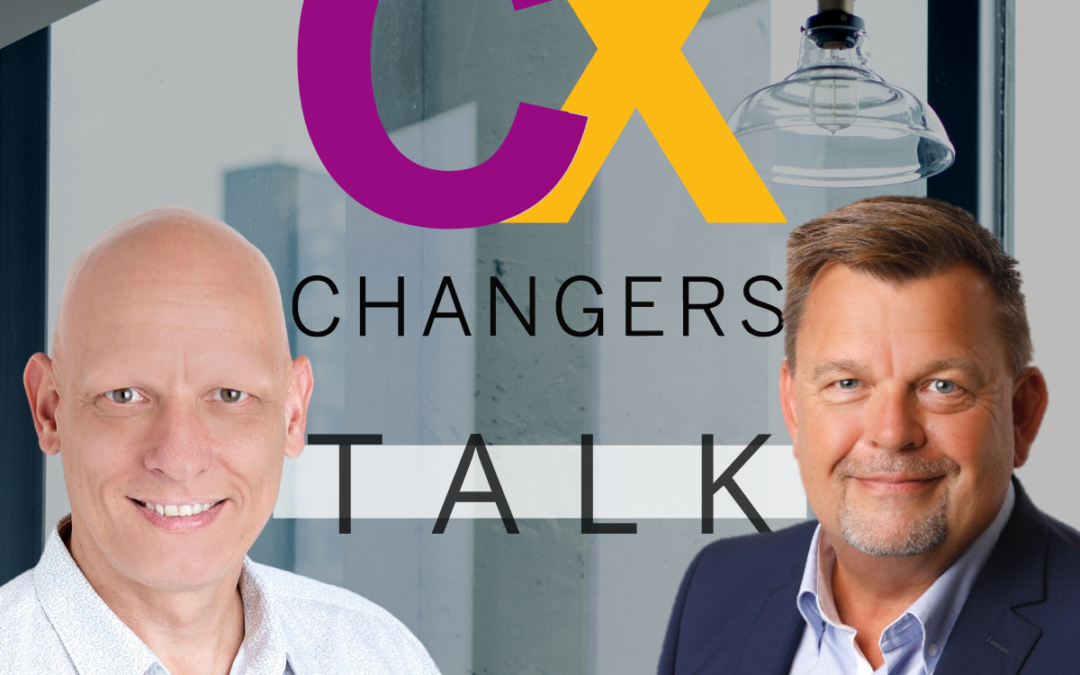
by twieberneit | Jul 15, 2022 | Blog, Sponsored |
One of the most overused buzzwords these days is „hyperpersonalization“. But, apart from the hyperbole around it – pun definitely intended – there are a lot of questions around this term, starting from, what is it? What is the purpose? Does it work at all? Does it have one or is it just a fad? After all, we know personalization since the early 80s, just that we called it 1:1 marketing then. Of course, we didn’t have the technology then to scale it, which is definitely something that we do have now. On the other hand, improving technology is faced by an increased desire for privacy, which is at odds with what hyperpersonalization, personalization in general, stands for. This blog post is based upon a CXChangersTalk that I had with CRM industry analyst Marshall Lager, who observes and shapes the industry since 2004 in various dependent and independent roles, most notably atCRM Magazine, G2 and Informa. In his words, hyperpersonalization “doesn’t go away and evolves constantly.” And, of course, it doesn’t always work! Marshall explains that one of the main reasons for this is that not every business has the right idea of what personalization, let alone hyperpersonalization, is. He continues that “To some, putting somebody’s personal name in an e-mail or in an ad on Facebook is hyperpersonalization because it’s going right to you. It’s your name. Hey Thomas, look at this. Your name is on a t-shirt that I am holding up on this ad. That’s not hyper personalization, that’s mass marketing, that just happens to have your name on it.” But then, how does it work? Or rather: What is...

by twieberneit | May 23, 2022 | Blog, Sponsored |
These days, Customer Data Platforms, or in brief CDPs, are one of the most discussed topics in the CX industry. Last time I looked, the CDP Institute counted more than 150 CDPs of different flavors that target different business challenges. This raises a lot of questions, chiefly: What is a CDP? Which business challenges do companies solve with a CDP and how do they approach the solution, i.e. how do they proceed implementing one? Let’s start at the beginning. According to the CDP Institute, a CDP is “packaged software that creates a persistent, unified customer database that is accessible to other systems”. Figure 1: A simple model of CDP functionalities Functionalities offered by CDPs reach from simple data gathering and unification to the activation and even active usage of information derived from customer data. This already shows the different business challenges that can be addressed with a CDP. It also shows, that the business challenges can be addressed in a way that provides increasing value to the business. As an aside: A good CDP always bases on a solid foundation of customer identities and the consents that customers have given. The second important question is how a CDP can or should be implemented. What is a viable approach? To learn more about these questions, we spoke with Mario Kurmann, Senior Product Manager CRM at Migros Fachmarkt AG in Switzerland. Mario was responsible for the initial CDP implementation and now for its continuous improvement. Migros is one of Switzerland’s biggest retailers. Fachmarkt, as part of Migros, basically operates five independent brands in the areas of sports, electronics, home improvement, furniture...

by twieberneit | Apr 28, 2022 | Blog, Sponsored |
These days, customer experience is one of the biggest topics. Many, if not most, vendors have restructured, reshaped, or just renamed their portfolios to reflect customer experience one way or the other. Customer experience is great, customer experience is valuable. Now, what is customer experience? According to Paul Greenberg’s definition, “customer experience is how a customer feels about a company over time”. Bruce Temkin defines customer experience as “the perception that customers have of their interactions with an organization.” Similarly, the Gartner Group defines customer experience as “the customer’s perceptions and related feelings cause by the one-off and cumulative effect of interactions with a supplier’s employees, systems, channels or products.” What all these definitions have in common is that they are talking about something that is not in the realm of the business and quite abstract. I often say that good customer experience (CX) is the new differentiator as products and services delivered by businesses are increasingly becoming a commodity. Only few brands can truly differentiate themselves based upon their products/services, price, placement, i.e., the classical tools of the marketing mix. This leaves customer experience as the lever that businesses can and need to work with. But customer experience is not an end. It is a means. Businesses mostly need to be profitable, which means that the CFO is always on the table when it comes to approving new projects or initiatives, even in important areas like customer experience. The CFO’s main questions are about financial KPIs – and are often not answered in a better way than “everybody knows that good customer experience is good for business”. This...

by twieberneit | Oct 19, 2021 | Analysis, Blog, Sponsored |
Zoho is a privately-owned technology company that was founded in 1996 as Adventnet, Inc. and has quietly evolved into an ambitious global player that serves the SMB and enterprise markets with cloud applications. The company offers a suite of more than 50 business, collaboration and productivity applications. These include applications for CRM, project management, finance, human resource management, analytics and support. The company is headquartered in Chennai, India. It has eleven offices in India, five in the United States and has offices in Brazil, Canada, Mexico, Australia, Japan, Singapore, China, Egypt, South Africa, United Arab Emirates and the Netherlands. Offices in France and Germany are in preparation. Zoho has more than 10,000employees as of mid-2021. It is present in 180 countries with more than 70 million users. Zoho is led by its co-founder and CEO Sridhar Vembu. Being a privately held company, Zoho is not obliged to, and does not publish revenue or profit numbers. However, the company indicates a track record of profitable growth that is well in the double digits. The company manages its growth organically, i.e. without acquisitions. All applications are built by Zoho, using one single hard- and software stack. They are deployed and delivered via Zoho owned data centers in the United States, Europe, India, China and Australia. Following this unique approach, the company has built a solid platform with a unified data model that allows it to grow and deliver software at high speed. Core values of Zoho include corporate self-determination, privacy as a principle and a commitment to delivering high value. Zoho One Zoho aspires to deliver the operating system of a business with the goal of driving customers’ margins by unifying business operations on one single technology platform. The most important part...

by twieberneit | Sep 9, 2021 | Blog, Sponsored |
Customer journeys are as individual as customers. Every customer has different needs, preferences, knowledge, information and another way to resolve their issues. In brief, every customer has a context of their own. As a consequence, customer journeys are often non-linear and move across different channels and devices. In between the online steps there might very well be some offline steps. Customer journeys are usually emerging sequences of interactions or engagements between the customer and the business towards a goal. This goal needs to be the customer’s goal, albeit in the limitations of a business environment. Customer journeys can, in fact, be compared to conversations, which are also not linear. With this thinking, it is only a small step to the thought that customers do manage and orchestrate their journeys individually and for themselves. Consequently, there is no need to design their journeys for them. It can even be counterproductive. A better approach is to provide customers with a channel independent menu of interconnected contact points that helps them to achieve their objective, their way. With the company offering – potentially different – contact points to different customers, both parties’ needs are mostly fulfilled; the business need for efficiency, the customers need to build and follow their own journeys, and both parties’ need for effectiveness. This raises the question about why we should be interested in these interconnected contact points. The answer is quite simple. What is the objective? Companies that are working towards supporting their customers’ needs and desires have an edge over their competitors. They have more success acquiring and retaining customers, even turning them into loyal advocates....

by twieberneit | Sep 1, 2021 | Blog, Sponsored |
Schools, universities and other educational institutions have one challenge in common. They need to constantly communicate with their students and often the parents as well. Obviously, the students and their parents are different generations; and guess what, that means they have different communication styles, prefer different communications channels and are on different timeframes. They also have different information needs. What they have in common is that they do have a smartphone and do not necessarily want to see yet another app on their phones’ home screens, or anywhere at all on their phones. They want and need timely information and an easy and simple way to supply information or, in the case of the students, work results. It is a valid assumption that the members of both stakeholder groups also have and use services like text and one or more messengers. Naturally, they all have email addresses. An increasing number of people also use unified communications software like MS Teams or Slack. And, let us not forget about the personnel on the other side, the teachers, assistants, or members of the school boards. Outbound use cases include attracting new students, ongoing information on offers and events to parents and students alike, requests for information, work assignments to students, notifications about upcoming deadlines for pending work, and many more. On the inbound side we have requests for information, submission of information and work results, again amongst many other use cases. And then, there is collaboration; virtual “classroom” education, townhall meetings, briefings, etc. Given all this, how can an educational institution effectively and efficiently communicate with its two main external stakeholder...







